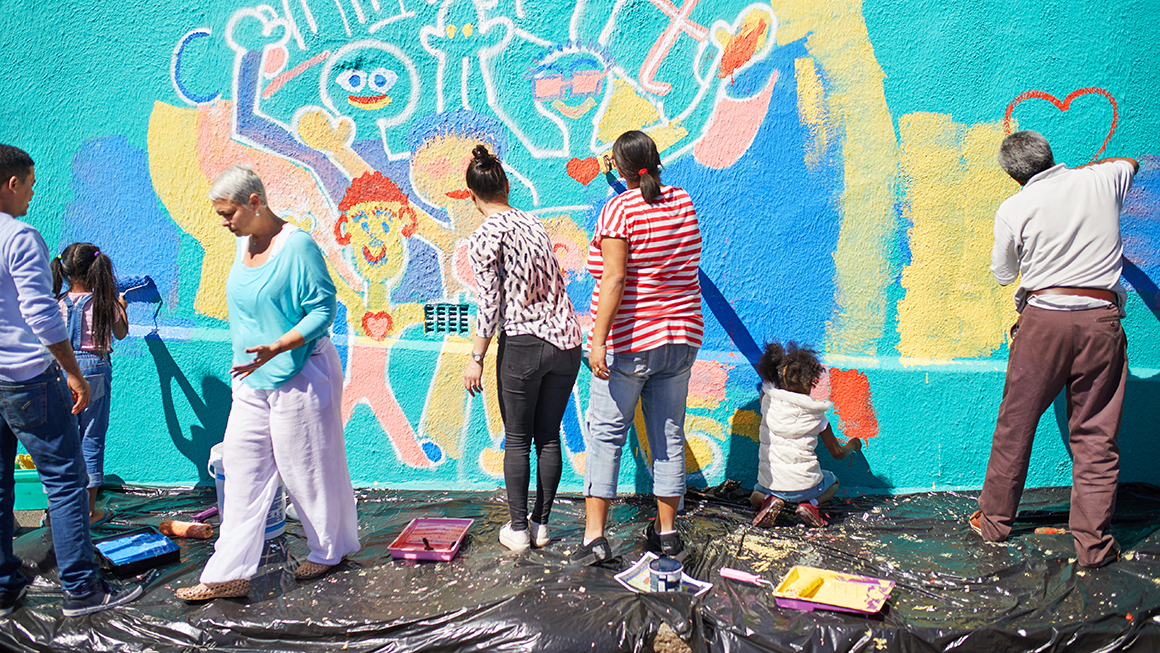
In 1961, urbanist and community activist Jane Jacobs observed that cities are like ecosystems—dense, diverse, and dynamic spaces, invigorated by activities that bring people together. This understanding of how people experience and use space is central to placemaking today. Beyond promoting better urban design, placemaking aims to improve cities and neighborhoods by creating spaces where people can thrive, build social connections, and feel like they belong.
City and county leaders play a critical role in both developing spaces and fostering community. Historically, however, government investment in civic infrastructure has been unequal, resulting in the spatial and economic marginalization of people of color and lower-income residents. To address these inequities, local governments can engage affected communities, understand their priorities, and invest in placemaking projects that bridge gaps in access without displacing residents. Sustaining these efforts will require identifying and securing adequate funding.
Here are four funding strategies local governments can use to advance equitable placemaking in their communities.
- Identify federal funding that can be used flexibly.
Although there are a few federal grants that specifically support placemaking, funding from other federal programs can be applied toward placemaking efforts.
Large federal investments, such as the American Rescue Plan Act and the Investment in Infrastructure and Jobs Act (IIJA), have created pathways for placemaking projects across the country. Broadly designated for transportation and infrastructure improvements, IIJA funding can be used to improve residents’ experience of their communities. Some state and local governments have allocated these funds toward creating bike lanes, planting street trees, supporting urban greening, and maintaining public parks and trails. Recognizing the traffic-related fatality rate was disproportionately higher among Black residents, several counties in California allotted funds from the IIJA to their local Safe Streets and Roads for All Program. The counties invested in road improvements, safer street design informed by resident input, and community education.
Federal support can aid local governments in their efforts to expand access to activated spaces, such as safe streets and parks, among residents of color. These resources can be used to deepen community engagement and ensure residents can meaningfully shape the design of their community spaces. Flexible funding can also help launch pilot projects or support economic development opportunities in underinvested neighborhoods.
- Leverage urban development financing to fund place-based initiatives.
Though typically used for capital development, neighborhood improvement and revitalization funds can also finance the activation of spaces. Tax Increment Financing, Business Improvement Districts (BID), and special districts can all be used to support placemaking. However, these efforts must be aligned closely with resident priorities to avoid further segregating community spaces.
By working closely with residents on placemaking projects, cities can effectively spend their planning dollars and achieve more targeted goals. In Grand Rapids, Michigan, local leaders developed the Downtown Grand Rapids BID to revitalize the urban center while uplifting its diverse residents. The BID invests in arts and culture programming, promotes historic preservation, and helps expand local entertainment options. To ensure this initiative would benefit residents’ diverse needs, the city engaged the public throughout the BID planning process; investments in racial equity, such as hiring staff in the Office of Equity and Engagement and regularly engaging resident input, have helped sustain this work.
- Partner with charitable foundations to sustain projects in the long term.
Some local and state entities use grants from philanthropic sources to develop agencies dedicated to placemaking. Setting up a department can help sustain resource allocation—in terms of both funding and staffing capacity—and ensure these projects remain a priority in the long term. Philanthropies often have more flexible, unrestricted funds than local governments that can be put toward funding the operations of an agency or department, freeing up government resources for programming.
In 2016, the Washington DC Office of Planning (DCOP) received a $1 million grant from the Kresge Foundation as part of their Strengthening the Equitable Creative Placemaking Field initiative. The DCOP used the grant funding to hire a team of staff to help launch several creative placemaking projects and civic engagement activities, including public art installations, community events, and support for small businesses and local artists. In the first two years (PDF), the DCOP completed 17 projects in 12 different types of spaces, engaging more than 17,000 participants.
- Mix and match different funding sources.
Securing placemaking funding from a single source is difficult (PDF). To advance equitable placemaking, local governments will likely need to seek funding from a variety of grants, government allocations, local organizations, and philanthropies.
The Indiana Housing and Community Development Authority (IHCDA) utilizes funding from several sources, including state funding, foundation grants, and crowdfunding, to support its placemaking efforts. The state funding provides communities with grants to launch placemaking projects as well as technical assistance and training. Communities have used these funds to create new parks and trails, renovate historic buildings, and activate public spaces. The IHCDA has used foundation grants to create the Placemaking Indiana Toolkit, develop the Placemaking Indiana Network, and support CreatINg Places’ downtown revitalization projects. CreatINg Places has also used crowdfunding to support neighborhood organizations’ place-based work. By combining funding from different sources, the IHCDA has sustained a pipeline of ideas and financial support for Indiana communities aiming to build vibrant, connected spaces.
Like securing funding, community input is a crucial component of any placemaking project. To ensure funding is put toward projects that narrow—rather than widen—disparities in the community, local governments should work to include community members in each step of the placemaking process.
Let’s build a future where everyone, everywhere has the opportunity and power to thrive
Urban is more determined than ever to partner with changemakers to unlock opportunities that give people across the country a fair shot at reaching their fullest potential. Invest in Urban to power this type of work.